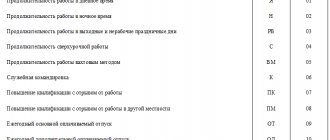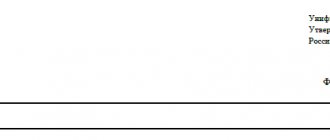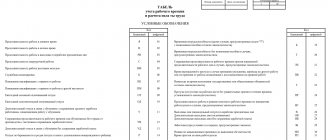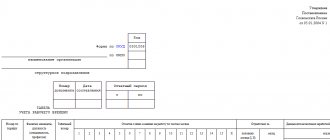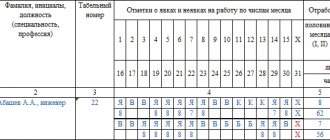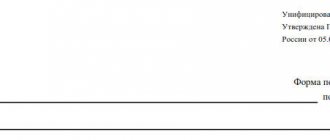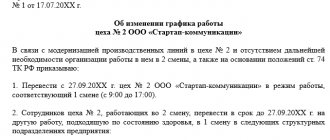A work schedule is a routine that must be followed in every organization. Duration of the working week and (or) shift, in accordance with Art. 100 of the Labor Code of the Russian Federation, is established by a collective agreement, an employment contract, and internal labor regulations.
In personnel records management, there are two concepts that are similar in sound, but different in meaning: a work schedule (planned) and a work accounting schedule, or time sheet (drawn up at the end of the month, using which the results are summed up). Let’s define the basic concepts, consider wage options with different work schedules and a sample employee return to work schedule, as well as other examples of documents.
So, in accordance with Art. 91 of the Labor Code of the Russian Federation, normal working hours should not exceed 40 hours per week. Planning and recording of working time worked by each employee is organized by the employer. Usually for such accounting they use unified forms T-12 or T-13. A monthly working time schedule using standardized forms can be found at the end of the article.
What is a work schedule
Labor legislation provides for standardized or irregular working hours for employees. It is established by internal labor regulations, collective agreements, agreements, and employment contracts.
Normal working hours include the following work schedule:
- 5-day week with 2 days off;
- 6 days with 1 day off;
- a week with days off on a rotating schedule or a part-time work week.
Labor standards specify what employee work schedules are. The main types are:
- single shift;
- weekly;
- sliding;
- removable;
- shift worker, etc.
In case of irregular working hours, a shift schedule is established for some categories of employees. This is a document that is established in accordance with Art. 103 of the Labor Code of the Russian Federation and is introduced when the duration of the production process exceeds the working time of the employee.
In production, groups of employees replace each other, and in order to ensure continuity of the process, it becomes necessary to work or provide services around the clock. To keep their working hours within the norm, shift schedules are introduced. Usually they are annexed to the collective agreement, and when approved, the opinion of the representative body of workers is taken into account.
IMPORTANT!
Micro-enterprises have the right to include a shift schedule in the employment contract with the employee. Write down the work schedule and rest time in this format (part 2 of article 57, part 1 of article 100, part 1 of article 104, article 107, 108 of the Labor Code of the Russian Federation):
- length of the working week;
- beginning, end and duration of work shifts, number of shifts per day;
- alternating working days and weekends;
- time of breaks, their duration;
- accounting period, if summarized working time accounting is maintained.
ConsultantPlus experts discussed how to create a work schedule during shift work. Use these instructions for free.
to read.
Additional leave
Due to the fact that with an irregular schedule, certain overtime occurs in excess of the standard length of the day, the Labor Code, as some compensation, establishes the possibility of employees receiving additional leave. Its duration is determined in the collective agreement or rules of procedure. Leave is paid and provided annually.
If such a vacation period was not provided, with the written consent of the employee, overtime is counted as overtime.
The conditions and rules for providing paid additional leave for employees of organizations financed by federal, regional, and local budgets are established by the Government, authorities of constituent entities or territorial self-government, respectively.
What are the differences from a time sheet?
It is necessary to distinguish the document recording the working hours from the timesheet of hours worked, which is maintained by the employer in accordance with the requirements of Art. 91 of the Labor Code of the Russian Federation and is a kind of document recording working hours for the month. The norm is 40 working hours per week. The employer is obligated to keep records of actual time worked for each employee.
There are no special requirements for familiarization with the report card within a certain period and there is no need to coordinate it with the representative body of employees. The employer can only not exceed the established duration of the working day and provide workers with rest in accordance with the requirements of Art. 110 Labor Code of the Russian Federation.
Keeping timesheets is mandatory for any organization. But with a continuous flow, when people work in shifts, a working time schedule is required. In both cases, it is necessary to specify in the employment contract all the specifics in the section that concerns the working hours.
Working hours
The types of sliding work schedules vary depending on the established accounting period in the organization, the time characteristics of the elements of the regime, and the conditions of their use in a particular department.
The maximum permissible length of the day (with a 40-hour week) does not exceed 10 hours. In some cases it can be within 12 hours.
Why do you need a work schedule?
Its functions are quite diverse. It is required for:
- streamlining employee work time;
- calculating wages when fulfilling specific obligations;
- calculating average earnings;
- benefit calculations;
- determining the employee’s insurance length;
- absence of errors in determining earnings and compensation for vacation (together with the working time sheet, it is the basis for calculating wages and other payments);
- identifying overtime overtime and determining additional payments.
After approval, the team is introduced to the schedule for signature one month before commissioning. If a signature is refused, a special act is drawn up with the signatures of two witnesses. Failure to comply with the established regime is a serious disciplinary offense.
Who is responsible for maintaining the work and rest schedule?
Both the employer and the driver are responsible for compliance. If a driver does not follow the schedule drawn up for him, he faces a fine of 1500-2000 rubles . If the schedule is drawn up in violation of the norms prescribed by Order No. 15, then the employer is responsible for this. For officials, the fine will be 7,000-10,000 rubles , for legal entities - 20,000-50,000 rubles , and for individual entrepreneurs - 15,000-25,000 rubles .
More articles on the topic: Who should install a tachograph in 2021, and who was given a deferment? Will you receive a fine “for tachograph”? Check yourself Fine “for the tachograph”: we have calculated how much you will pay for the absence or blocking of the tachograph and violation of the work and rest schedule.
Only until October 16 you have the opportunity to equip your vehicles with tachographs under special conditions!
Is there a required form?
There is no unified form: each employer has the right to independently develop its own document form or use a ready-made template. Instructions on how to make a work schedule for a month in Excel or any other editor:
- Prepare a database to fill out: indicate the name and registration information of the organization.
- List all employees and their positions.
- Mark the days on which each employee comes to work.
Develop the document in such a way as to prevent shortcomings or rework beyond normal working hours and ensure optimal workload on the team and on production processes. The schedule is most often developed for a month.
Features of application
Flexible mode is used when other types of work schedules are inappropriate or ineffective due to various reasons (domestic, social, etc.). Often it allows for more coordinated team activities.
At the same time, the use of a flexible mode is impractical in continuous production and shift work schedules (their types can be installed in both discontinuous and continuous production) if there are no free places at the shift junctions.
The flexible mode can be used for both a five- and six-day week, as well as for other modes. At the same time, the conditions for rationing and payment of wages do not change. The conditions for providing benefits, accrual of length of service, and other rights are also preserved. It must be said that the registration of work books is carried out without mentioning the mode of labor activity.
Filling procedure
The general rules for creating a schedule are simple. Here's how to create a duty schedule for a month in the form of a table without errors:
- Fill out the document taking into account the working hours in accordance with the internal labor regulations in force in the organization. Indicate the beginning and end, duration of the working day, breaks, number of shifts, alternation of work and rest.
- Keep track of the length of the working day. The duration is regulated by internal regulations, taking into account the working time regime established by the employment contract.
- If necessary, provide for a shorter working day, as, for example, in industries with harmful and dangerous conditions (Part 4 of Article 94 of the Labor Code of the Russian Federation) or when the work of disabled people and minors takes place (Parts 1, 3 of Article 94 of the Labor Code of the Russian Federation) .
Prerequisites
To apply a flexible mode, the enterprise must have a clear system for recording the time worked by employees and their completion of production tasks. In addition, control over the most complete and rational use of time by each employee in both fixed and flexible periods must be ensured.
It should be noted that the use of this regime is regulated by several regulations. For example, the Order of the Ministry of Communications approved a list of employees for whom a flexible schedule may be provided.
Where and how long is it stored?
Order No. 236 of Rosarkhiv dated December 20, 2019 established the storage periods for personnel documentation. Clause 8.1 of Section II of the order states that books, journals, accounting cards and databases are stored for 5 years. When working with difficult, harmful and dangerous working conditions, the shelf life is set at 75 years or 50 years if the document was completed after 01/01/2003.
There is no specific reference in the order regarding how long to keep the work schedule. Still, some employers prefer to store such documents for a year in the human resources or accounting department in case of a labor dispute with an employee regarding the issue of standardization of working hours or payroll.
Shift method
This is a special form of organizing work activities outside the place of residence of personnel. The rotation method is used if, due to the nature of their work, employees cannot return home every day.
This mode is used to reduce the construction, reconstruction, and repair time of social and industrial facilities in uninhabited, remote areas, and in regions with special climatic conditions.
The specificity of the rotational method is that the personnel are accommodated in rotational camps - complexes of structures and buildings used to ensure the recreation and vital functions of personnel.
How to compose
Here the compiler is given freedom of action, since there is no specialized form for compilation. The shift schedule is drawn up in free form, but must include the following mandatory positions:
- Shift duration
- Start of shift and end of shift
- Full name of employees related to the shift
- Features of scheduling shifts
Articles 91 and 104 of the Labor Code imply that any processing should be excluded. Accordingly, it is important for you, or your employee responsible for scheduling, to ensure that the employee is not more busy than indicated in the production calendar norm.
Make sure the timesheet is correct. It is impossible to allow not only general overtime for a period, but also for a day (Article 94 of the Labor Code).
But the employee’s uninterrupted rest must also be controlled - no more than forty-two hours in one week.
According to Article 95 of the same code, it follows that on the day followed by a holiday, a shift must be reduced by one hour.

